Success lies in having the right team, training, patients and equipment
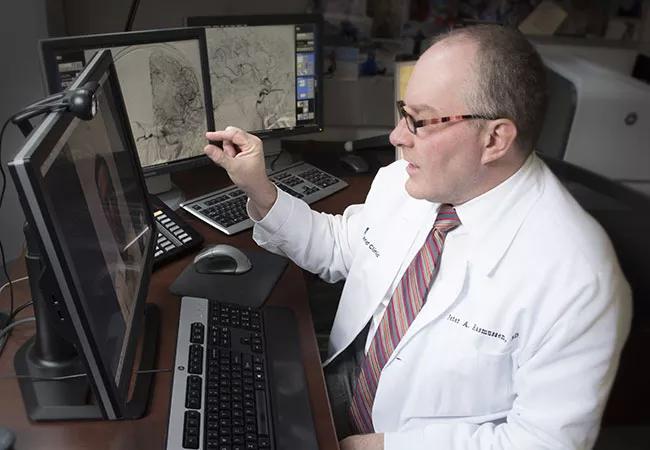
By Stephen D. Samples, MD; Kuruvilla John, MD; and Tara Schubert, MS
Cleveland Clinic is a non-profit academic medical center. Advertising on our site helps support our mission. We do not endorse non-Cleveland Clinic products or services. Policy
As the U.S. geriatric population continues to swell, the nation’s neurologist shortage looms ever larger, especially for small and/or rural hospitals that lack full-time neurologist coverage. As a result, increasing numbers of small or remotely located hospitals are looking to large, highly specialized health systems for teleneurology services.
Cleveland Clinic has been offering such services through the Cleveland Clinic Teleneurology Program since early 2015, first for select Cleveland Clinic regional hospitals without 24/7 neurologist coverage and increasingly to external hospitals. The program uses distance health technology to provide basic neurological services to hospitalized patients with noncritical neurological illnesses. It’s distinguished by the fact that it extends beyond the core services of emergency assessment for stroke or limited outpatient triage to include robust, thorough consultations enabling clinical decision-making for a range of neurological conditions.
Teleneurology offers a number of potential benefits, including:
This article shares insights we’ve gained in the process of establishing and refining our program, with a focus on how to get things right in four essential aspects of teleneurology care.
In our model of the teleneurology visit, the patient (perhaps with family members) is present at his or her local hospital or health facility with a specially trained nurse who works at that facility. They are connected via video connection, established through a mobile transmission unit, with a neurologist located remotely at a Cleveland Clinic facility, who directs the visit in collaboration with the nurse.
The neurologist takes a history and actively guides the nurse through a full neurological examination of the patient, with the nurse acting as the “telepresence.” The history and exam can be supplemented by imaging studies obtained on-site as needed (and transmitted to the neurologist in real time via the mobile unit or remote connection to the EMR), as most smaller/remote partner hospitals have imaging modalities sufficient for diagnosing teleneurology-appropriate conditions.
Drawing on all these elements (history, nurse-enabled exam, any imaging studies), the neurologist then discusses his or her assessment and plan with the patient via the video connection and also with the referring physician, either via the mobile transmission unit or by telephone.
This model relies on three critical elements:
The trained nurses have been crucial to the program’s success. By serving as physician extenders, they provide the human factor that patients expect while enabling the service to be economically feasible. Moreover, the experienced neurology clinicians in our program have consistently found the guided neurological examination completed by trained nurses to be sufficient for diagnosis.
That degree of confidence requires the right approach to nurse training, which begins by enlisting nurses at the partner facility who have had some exposure to neurology — e.g., from experience as ICU nurses or ER nurses who have routinely performed NIH Stroke Scale evaluations.
The training programs for nurses are delivered either one day a week for six weeks or as an intensive 14-hour weekend program, with all neurologists involved in the teleneurology program participating. These programs are usually at the remote hospital and allow the neurologists and nurses to interact as colleagues. Nurses then spend at least two days rotating with participating Cleveland Clinic attending neurologists in a hospital setting. We’ve found this sufficiently equips nurses with a wide range of skills to perform a guided neurological examination that provides reliable, reproducible information.
The box below lists a sampling of neurological complaints and conditions that are commonly evaluated and managed with success via our teleneurology program. Once an accurate diagnosis is reached, it guides the decision whether the patient needs to be transferred to a more specialized hospital for higher-level service. In many cases, with appropriate diagnosis, there is no need to transfer patients elsewhere.
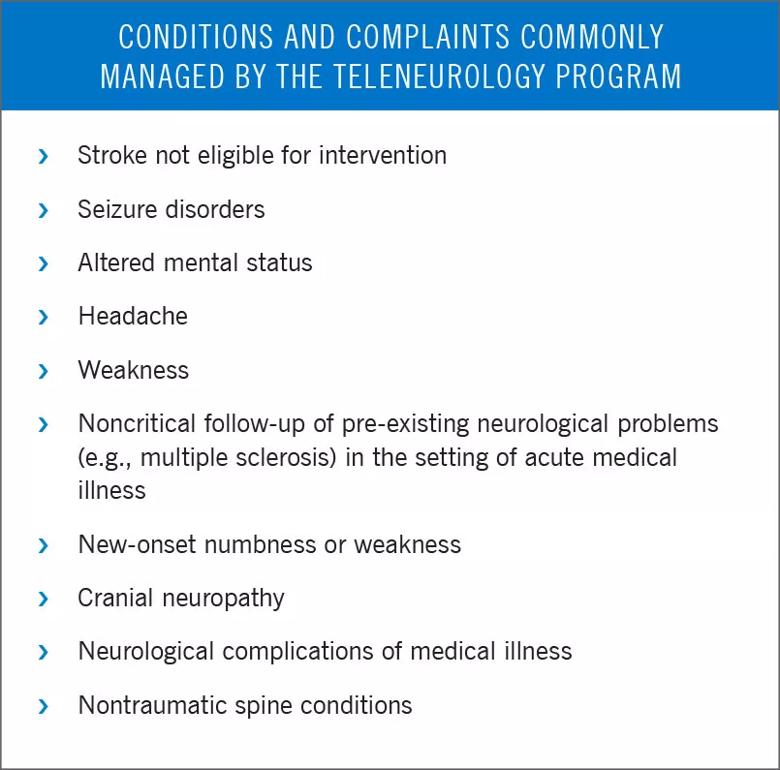
Of course, certain aspects of neurologic evaluation, such as assessment for subtle findings in muscle tone, do not translate well in teleneurology. And other challenging situations, such as evaluation of brain death, cannot be reliably performed via teleneurology. A good approach is to predefine general guidelines for teleneurology-appropriate conditions and complaints and be open to refinements as experience dictates.
Telehealth programs require dedicated hardware and robust Internet connections. Several HIPAA-compliant hardware solutions are available, with varying levels of expense and support. All devices provide asynchronous connection for video/audio communications. In addition, some provide stethoscopes or other equipment for further evaluation. For teleneurology, the essential requirement is a basic system that transmits video and audio reliably.
The mobile units employed in our program automatically correct for variation in internet connection speed and allow for accurate monitoring of movements. They operate in a wide range of lighting and other variables. Through use of a pan-tilt-zoom video lens, these units enable close observation and facilitate examination. A good system provides sufficient resolution to allow remote examination of the pupil.
Patients have responded positively to the teleneurology program, with virtually all rating the service they received at the highest level in surveys. Verbatim patient comments have included “felt like the doctor was in the room” and similar statements. Most consultation requests come from internists, hospitalists , family practitioners and physician extenders.
Although referring physicians were initially reluctant to use teleneurology, the number of consults per month increased dramatically after the first few months and continues to grow. Two-thirds of referring physicians who’ve used the service have rated it as good or excellent.
A host of factors have converged to spur interest in teleneurology, from neurologist shortages to limits in some patients’ travel abilities to changes in reimbursement. Our experience shows that neurological services can be provided efficiently using telemedicine systems, including in smaller or rural hospitals with limited services.
The authors gratefully acknowledge all the teleneurology program’s participating neurologists and nurses, most notably Sheila Rubin, MD, who developed the curriculum to train nurses in the neurological examination.
Dr. Samples is Director of the Center for Regional Neurosciences in Cleveland Clinic’s Neurological Institute.
Dr. John is Director of Teleneurology in the Center for Regional Neurosciences.
Ms. Schubert is the administrator for the Center for Regional Neurosciences.
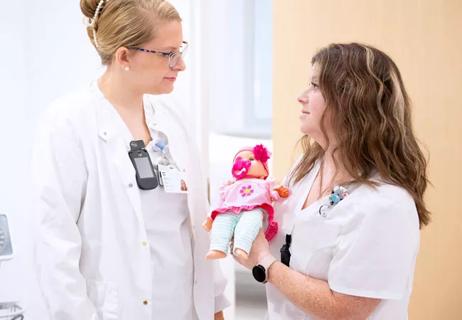
Pilot study confirms feasibility of conducting additional research on the novel treatment

Longer hospitalization does not mean a safer, faster recovery for patients age 70+

Structured data helps identify older adults at risk for poor outcomes, defines patients who require more comprehensive assessments
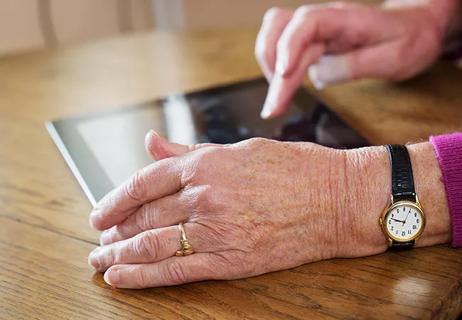
Self-administered tool can be completed in 10 minutes in waiting room

Social prescribing turns leisure activities into good “medicine”
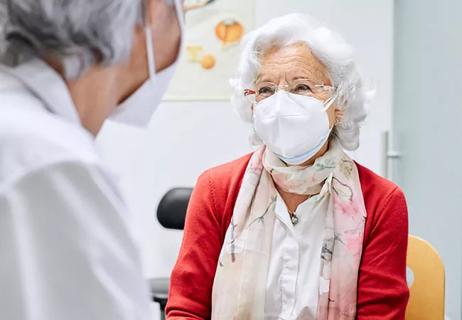
A large geriatric study aims to find the answers
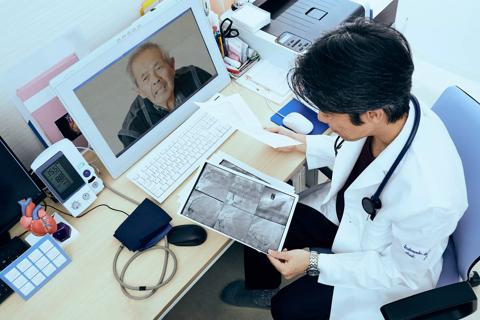
Analysis underscores how telehealth can help pinpoint elder abuse